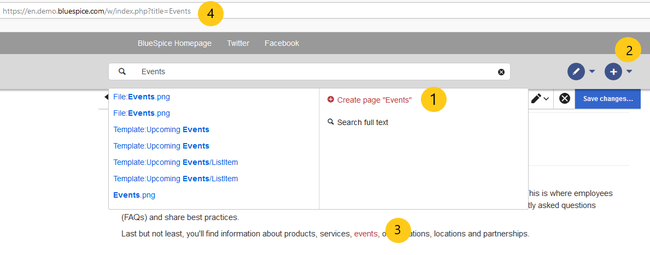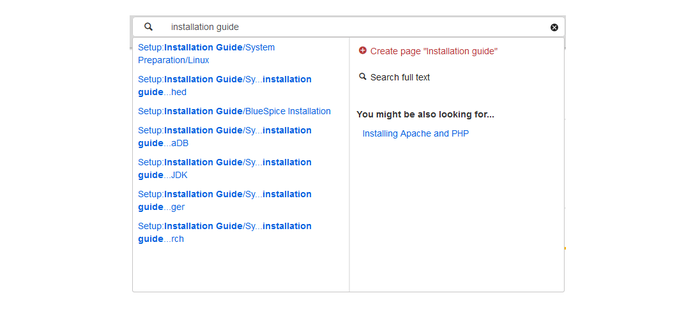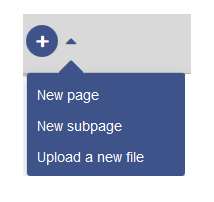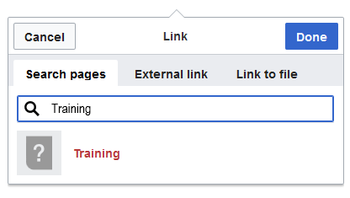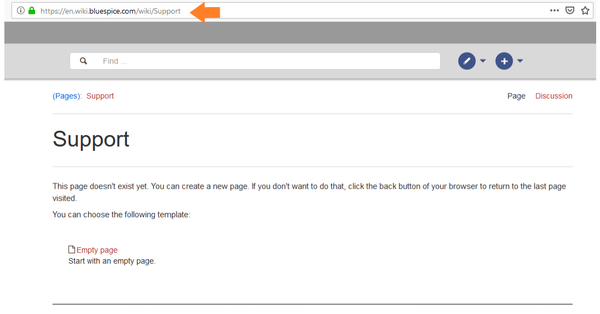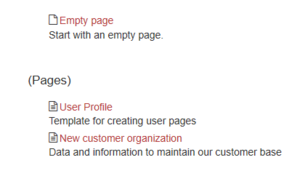Difference between revisions of "Manual:Create pages"
| [unchecked revision] | [quality revision] |
m |
(Tag: 2017 source edit) |
Contents
Together we know more[edit | edit source]
There are four ways to create a new article in BlueSpice.
You should normally, however, first look to see if the article already exists. Search for the term and for synonyms. If your search does not have any hits, you can create the page.
Good to know:
- To create an article in a different namespace, you must write the namespace before the article name, for example [[NewNamespace: First_Article]].
- After entering the page title, a menu will appear which contains the wiki's specific page templates.
-
The following symbols cannot be used in titles:
{ } & ? < > \and, -
The symbol
/should only be used when you are creating a subpage!
An important aspect of the wiki principle is that information can be shared with other people quickly and without any "red tape". Every wiki user with edit rights should therefore be able to create and edit a page at least in the (Main) namespace without any prior knowledge or without special privileges to contribute to the company knowledge.
How do I create a page?[edit | edit source]
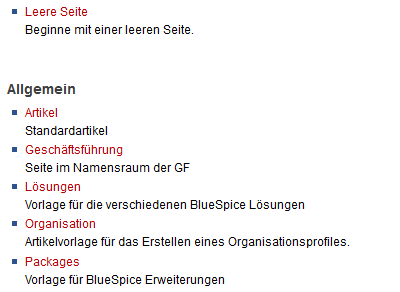 Screenshot: Choosing a templateIt does not matter which of the methods described below you use, you will always be forwarded to an overview page where you can choose from different templates (if they are available). If you do not want to use a template, click on empty page or directly on create.You will then be able to write content to the page. As soon as it is saved, the article exists.
Screenshot: Choosing a templateIt does not matter which of the methods described below you use, you will always be forwarded to an overview page where you can choose from different templates (if they are available). If you do not want to use a template, click on empty page or directly on create.You will then be able to write content to the page. As soon as it is saved, the article exists.
Creating a new article via the search function
There are four ways to create a new page in BlueSpice:
- using the search box
- using the "New Page" button
- using a text link (redlink)
-
using the web address ("url")
Using the search field[edit | edit source]
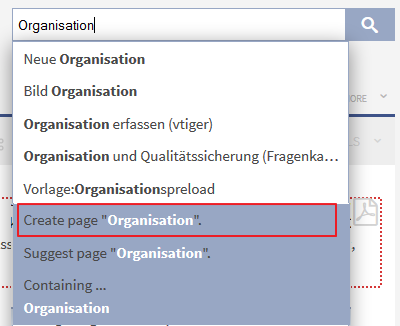 Screenshot: Create a page via the search functionFirst, search for a term or content using the search function. Also try searching for synonyms and similar terms. If your search returns no hits, then you can click on "create", directly below the search box. You are then forwarded to the page to be created.
Screenshot: Create a page via the search functionFirst, search for a term or content using the search function. Also try searching for synonyms and similar terms. If your search returns no hits, then you can click on "create", directly below the search box. You are then forwarded to the page to be created.
Create a new article via URL
Maybe information about your topic already exists. Before you create a new page, you can use the search to enter terms for your topic and check existing pages. If there is no page on your topic yet, click on the red link 'Create page [page name]' in the search results:
Using the "New page" button[edit | edit source]
Just like creating a page via a link in some text, you can also just enter the URL.
To do this, go to your browser's address bar. You will see something like http://help.blue-spice.org/index.php
Add a slash and the page name after this, and press the return key. You will automatically be forwarded to the start form for the new page.
http://help.blue-spice.org/index.php/Enter_URL
Create a new article via a link in the text
Next to the search box is a button to create a page. This button is only activate if you are logged in and have write permissions on the wiki (or in a specific namespace):
Here you can create a page or a subpage of the current page. In addition, you can also upload a file (image, PDF, Word file, etc.) to the wiki.
Using a text link (redlink)[edit | edit source]
A classical way to create articles in MediaWiki is by using "Red links". These are links in the text to the article to be created, and clicking on these creates the page. This means that the wiki pages are immediately linked to each other.
Suppose we want to, for example, create the article "Training". It is not absolutely necessary, but it is useful to have this new page linked to other pages in the wiki. To create this connection, generate a reference to the page "Training". This is done by changing to the edit mode. Then add the following to a page of your choosingLet's say that you want to create the "Training" page. You can directly select any text on the current page and define it as a link to a new page. This creates a so-called redlink. From them on, the link exists, but there is no wiki page for it. The example page "Training" is thus also listed on the Special page WantedPages.
With VisualEditor: Click the Link button () or press Ctrl+K to create a page. Now enter the page name. If there is no page with this name, the page name is shown in red and the page icon shows a question mark. Click "Done" to create the redlink.
In the source text:
[[Training]]
Confirm the creation of the link by saving it. Screenshot: A "Redlink" in a textThe double square brackets make the wiki software recognise the phrase "Training" as a reference to the article "Training" and so display it as a link to this page. Because this page Since the page does not yet exist, this the link is shown in red . All redlinks are listed in the wanted articles. If you now click on this link to "Hello World", the editing view appears automatically. You can enter whatever text you like here. After saving, you will see the page you have just created.
Screenshot: A "Redlink" in a textThe double square brackets make the wiki software recognise the phrase "Training" as a reference to the article "Training" and so display it as a link to this page. Because this page Since the page does not yet exist, this the link is shown in red . All redlinks are listed in the wanted articles. If you now click on this link to "Hello World", the editing view appears automatically. You can enter whatever text you like here. After saving, you will see the page you have just created.
It is useful to create links to the new page from a selection of places, particularly the topic's portal page, so that others can find the new page.
Active links to already existing pages are coloured blue.
Create a new article in a namespace[edit | edit source]
New articles/pages in a namespace can be created by using the "Create new page" form simply by creating an article whose address starts with the namespace, for example "Help:New Article".
Tips for creating pagesafter saving:
Using the web address[edit | edit source]
You can also create a page directly from the address bar of your web browser:
Simply exchange the current page name with a new one. Here, we create a page "Support" in the main namespace (Main) in the BlueSpice Helpdesk: https://de.wiki.bluespice.com/wiki/Support
Selecting a template[edit | edit source]
When you create a page, you are always redirected to an overview page. There, select a page template:
Creating a new page in a namespace: To create a new page in a namespace, put the name of the namespace in front of it, followed by a colon. Example: Help:New_Article
Tips[edit | edit source]
- Try Browser navigation: When creating pages, try not to use the "back" button whenever possible. Many browsers use the page cache to lower loading times, so you may be given an older version of the page. The worst case scenario is that the browser resends data from the edit form from the edit view, which could overwrite newer changes.
Note: Do you think that an article will often be searched for using a synonym? Then add an article with this name and use a redirect.
- The Choice of a suitable title is extremely important. Especially for wikis with many entries, it is common for authors to "take a chance" by inserting links to pages which they see as important for their input. You should, therefore, take care that the title is as succinct as possible and precisely describes what the page is about. Individual words are often very good, but short sentences such as "Why wikis work" can also be useful names. On top of this, descriptive page titles also help readers to navigate and search for entries more easily.
- When linking to a page that already exists, you should take care to use the title exactly as written. If, for example you write . You could lose content that you have not yet saved or that you want to edit again.
- Redirects: Do you have the impression that an article title is searched more often with a different synonym? Then create a new article with this name first. Then redirect the page.
- Title choice: In a wiki, titles are very important. In wikis with many entries, authors may make references to pages that they deem important in the context of their entry. The page title should, therfore, clearly communicate its contetn. Single words are very good, but even short sentences like "why wikis work" can be useful names. In addition, meaningful page titles also help readers find their way around when they search for an entry.
- Spelling: When linking to an already existing page you should pay attention to their exact spelling. If you e.g. typing a [[hello world]] instead of [[Hello World]] , it will create a new article because page as the links are written spelled differently. So make sure you take capitalisation Therefore, consider also capitalization and spaces into account.
- . Only at the beginning of the letter does it make no difference whether you write a small or capital letter.
-
Namespaces: If you want to create an article in a different namespace, the namespace must appear before article name. Example:
[[namespace:article name]].
-
Special characters: The following characters cannot be used in titles :
{ } & ? < > \and,. For more information, see mediawiki.org/wiki/Manual:Page_title.
-
Subpages: The character
/is used to create a subpage.
Related info
__NOTOC__ It is an==Together we know more== An important aspect of the wiki principle is that every user information can create articles. ==Creating new articles== There are four ways to create a new article in BlueSpice.<br/> You should normally, however, first look to see if the article already exists. Search for the term and for synonyms. If your search does not have any hits, you can create the page.<br /> Good to know: * To create an article in a different namespace, you must write the namespace before the article name, for example <nowiki>[[NewNamespace: First_Article]]</nowiki>. * After entering the page title, a menu will appear which contains the wiki's specific [[PageTemplates|page templates]]. * The following symbols '''cannot''' be used in titles: <code> { } & ? < > \ </code> and <code>,</code> * The symbol <code>/</code> should only be used when you are creating a [[Subpage|subpage]]! ===Using templates=== [[File:BlueSpice-Neuen_Artikel_anlegen-Vorlagen.png|thumb|left|400px|Screenshot: Choosing a template]]It does not matter which of the methods described below you use, you will always be forwarded to an overview page where you can choose from different templates (if they are available). If you do not want to use a template, click on ''empty page'' or directly on ''create''.You will then be able to write content to the page. As soon as it is saved, the article exists.<br/><br/><br/><br/><br/><br /><br /><br /><br /><br /><br /><br /> ===Creating a new article via the search function=== [[File:BlueSpice223-Suche-Seite_erstellen-en.png|thumb|left|400px|Screenshot: Create a page via the search function]] First, search for a term or content using the search function. Also try searching for synonyms and similar terms. If your search returns no hits, then you can click on "create", directly below the search box. You are then forwarded to the page to be created. <br /><br /><br /><br /><br /><br /><br /><br /><br /><br /><br /> ===Create a new article via URL=== Just like creating a page via a link in some text, you can also just enter the URL. To do this, go to your browser's address bar. You will see something like '''<nowiki>http://help.blue-spice.org/index.php</nowiki>''' <br />Add a slash and the page name after this, and press the return key. You will automatically be forwarded to the start form for the new page. <pre><nowiki>http://help.blue-spice.org/index.php/Enter_URL</nowiki></pre> ===Create a new article via a link in the text=== A classical way to create articles in MediaWiki is by using "Red links". These are '''links in the text''' to the article to be created, and clicking on these creates the page. This means that the wiki pages are immediately linked to each other. Suppose we want to, for example, create the article "Training". It is not absolutely necessary, but it is useful to have this new page linked to other pages in the wiki. To create this connection, generate a reference to the page "Training". This is done by changing to the edit mode. Then add the following to a page of your choosing: <pre><nowiki>[[Training]]</nowiki></pre> Confirm the creation of the link by saving it.[[File:BlueSpice-Redlink-en.png|thumb|left|220px|Screenshot: A "Redlink" in a text]] The double square brackets make the wiki software recognise the phrase "Training" as a reference to the article "Training" and so display it as a link to this page. Because this page be shared with other people quickly and without any "red tape". Every wiki user with edit rights should therefore be able to create and edit a page at least in the (Main) namespace without any prior knowledge or without special privileges to contribute to the company knowledge. ==How do I create a page?== <section begin="training" /><div class="training"> [[File:Manual:createpage-4-ways.png|alt=Ways to create a new page|center|thumb|650x650px|Ways to create a new page]] There are four ways to create a new page in BlueSpice: *using the search box *using the "New Page" button *using a text link (redlink) *using the web address ("url") <br /> <section end="training" /></div> ===Using the search field=== Maybe information about your topic already exists. Before you create a new page, you can use the search to enter terms for your topic and check existing pages. If there is no page on your topic yet, click on the red link 'Create page ''[page name]''<nowiki/>' in the search results: [[File:search field new.png|700x700px]] ===Using the "New page" button=== Next to the search box is a button to create a page. This button is only activate if you are logged in and have write permissions on the wiki (or in a specific namespace): [[File:New Page.png|214x214px]] Here you can create a page or a subpage of the current page. In addition, you can also upload a file (image, PDF, Word file, etc.) to the wiki. ===Using a text link (redlink)=== Let's say that you want to create the "Training" page. You can directly select any text on the current page and define it as a link to a new page. This creates a so-called redlink. From them on, the link exists, but there is no wiki page for it. The example page "Training" is thus also listed on the Special page [[Special:WantedPages|WantedPages]]. With VisualEditor: Click the Link button () or press Ctrl+K to create a page. Now enter the page name. If there is no page with this name, the page name is shown in red and the page icon shows a question mark. Click "Done" to create the redlink.[[File:training.png|alt=Screenshots: Create page with a redlink|center|350x350px]] In the source text: When editing the source code, enter the new page name as a link:<pre><nowiki>[[Training]]</nowiki></pre>Since the page does not yet exist, thisthe link is shown in red. All redlinks are listed in the [[WantedArticles|wanted articles]]. If you now click on this link to "Hello World", the editing view appears automatically. You can enter whatever text you like here. After saving, you will see the page you have just created. It is useful to create links to the new page from a selection of places, particularly the topic's portal page, so that others can find the new page. '''Active links''' to already existing pages are coloured '''<span style="color: #0000ff;">blue</span>'''. ===Create a new article in a namespace=== New articles/pages in a namespace can be created by using the "Create new page" form simply by creating an article whose address starts with the namespace, for example "Help:New Article". ==Tips for creating pages== * Try '''not to use the back button''' whenever possible. Many browsers use the page cache to lower loading times, so you may be given an older version of the page. The worst case scenario is that the browser resends data from the edit form from the edit view, which could overwrite newer changes. {{Box_Note|Note text =Do you think that an article will often be searched for using a synonym? Then add an after saving: [[File:training_2.png|left|250x250px]] ===Using the web address=== You can also create a page directly from the address bar of your web browser: [[File:support.png|600x600px]] Simply exchange the current page name with a new one. Here, we create a page "Support" in the main namespace (Main) in the BlueSpice Helpdesk:<syntaxhighlight lang="html"> https://de.wiki.bluespice.com/wiki/Support </syntaxhighlight> ==Selecting a template== When you create a page, you are always redirected to an overview page. There, select a [[Reference:BlueSpicePageTemplates|page template]]: [[File:create-page-choose-template.png|link=https://en.wiki.bluespice.com/wiki/File:create-page-choose-template.png|alt=Screenshot: choose template|center|300x300px]] '''Creating a new page in a namespace:''' To create a new page in a namespace, put the name of the namespace in front of it, followed by a colon. Example: <code>Help:New_Article</code> ==Tips== *'''Browser navigation:''' When creating pages, try not to use the "back" button. You could lose content that you have not yet saved or that you want to edit again. *'''Redirects:''' Do you have the impression that an article title is searched more often with a different synonym? Then create a new article with this name and use a [[Redirects|redirect]].}} * The '''Choice of a suitable title''' is extremely important. Especially for first. Then [[Manual:Using Redirects|redirect]] the page. *'''Title choice:''' In a wiki, titles are very important. In wikis with many entries, it is common for authors to "take a chance" by inserting links to pages which they see as important for their input. You should, therefore, take care that the title is as succinct as possible and precisely describes what the page is about. Individual words are often very good, but short sentences such as "Why wikis work" can also be useful names. On top of this, descriptiveauthors may make references to pages that they deem important in the context of their entry. The page title should, therfore, clearly communicate its contetn. Single words are very good, but even short sentences like "why wikis work" can be useful names. In addition, meaningful page titles also help readers to navigate and search for entries more easily. * When linking to a page that already exists, you should take care to use the title '''exactly as written'''. If, for example you writefind their way around when they search for an entry. *'''Spelling:''' When linking to an already existing page you should pay attention to their exact spelling. If you e.g. typing a <nowiki>[[hello world]]</nowiki> instead of <nowiki>[[Hello World]]</nowiki>, it will create a new article becausepage as the links are writtenspelled differently. So make sure you take capitalisation and spaces into account. ==Video tutorial: "How do I create a new page?"== {{#ev:youtube|l0z1zMHy4xM|450}}Therefore, consider also capitalization and spaces. Only at the beginning of the letter does it make no difference whether you write a small or capital letter. *'''Namespaces:''' If you want to create an article in a different namespace, the namespace must appear before article name. Example:<code><nowiki>[[namespace:article name]]</nowiki></code>. *'''Special characters:''' The following characters '''cannot''' be used in titles : <code> { } & ? < > \ </code>and <code>,</code>. For more information, see [https://www.mediawiki.org/wiki/Manual:Page_title mediawiki.org/wiki/Manual:Page_title]. *'''Subpages:''' The character <code>/</code> is used to create a [[subpage|subpage]]. {{Box_Links-en | Topic1 =[[Rename_and_move_pages|Rename and move pages]]| Topic2 =[[Redirects|Redirects - Using Synonyms]] | Topic3 =[[Reference:BlueSpicePageTemplates|Creating and Using Page Templates]] | Topic4 = }} [[en:{{FULLPAGENAME}}]] [[de:Seiten_erstellen]] [[Category:Editing]]
| (25 intermediate revisions by 5 users not shown) | |||
| Line 1: | Line 1: | ||
| − | + | ==Together we know more== | |
| + | An important aspect of the wiki principle is that information can be shared with other people quickly and without any "red tape". Every wiki user with edit rights should therefore be able to create and edit a page at least in the (Main) namespace without any prior knowledge or without special privileges to contribute to the company knowledge. | ||
| − | + | ==How do I create a page?== | |
| + | <section begin="training" /><div class="training"> | ||
| + | [[File:Manual:createpage-4-ways.png|alt=Ways to create a new page|center|thumb|650x650px|Ways to create a new page]] | ||
| + | There are four ways to create a new page in BlueSpice: | ||
| − | == | + | *using the search box |
| − | + | *using the "New Page" button | |
| − | + | *using a text link (redlink) | |
| + | *using the web address ("url") <br /> | ||
| + | <section end="training" /></div> | ||
| + | ===Using the search field=== | ||
| + | Maybe information about your topic already exists. Before you create a new page, you can use the search to enter terms for your topic and check existing pages. If there is no page on your topic yet, click on the red link 'Create page ''[page name]''<nowiki/>' in the search results: | ||
| − | + | [[File:search field new.png|700x700px]] | |
| − | |||
| − | |||
| − | |||
| − | ===Using | + | ===Using the "New page" button=== |
| − | + | Next to the search box is a button to create a page. This button is only activate if you are logged in and have write permissions on the wiki (or in a specific namespace): | |
| − | + | [[File:New Page.png|214x214px]] | |
| − | [[File: | ||
| − | + | Here you can create a page or a subpage of the current page. In addition, you can also upload a file (image, PDF, Word file, etc.) to the wiki. | |
| + | ===Using a text link (redlink)=== | ||
| + | Let's say that you want to create the "Training" page. You can directly select any text on the current page and define it as a link to a new page. This creates a so-called redlink. From them on, the link exists, but there is no wiki page for it. The example page "Training" is thus also listed on the Special page [[Special:WantedPages|WantedPages]]. | ||
| + | With VisualEditor: Click the Link button () or press Ctrl+K to create a page. Now enter the page name. If there is no page with this name, the page name is shown in red and the page icon shows a question mark. Click "Done" to create the redlink.[[File:training.png|alt=Screenshots: Create page with a redlink|center|350x350px]] | ||
| + | In the source text: | ||
| + | When editing the source code, enter the new page name as a link:<pre><nowiki>[[Training]]</nowiki></pre>Since the page does not yet exist, the link is shown in red after saving: | ||
| + | [[File:training_2.png|left|250x250px]] | ||
| − | === | + | ===Using the web address=== |
| − | + | You can also create a page directly from the address bar of your web browser: | |
| − | + | [[File:support.png|600x600px]] | |
| − | < | + | Simply exchange the current page name with a new one. Here, we create a page "Support" in the main namespace (Main) in the BlueSpice Helpdesk:<syntaxhighlight lang="html"> https://de.wiki.bluespice.com/wiki/Support |
| + | </syntaxhighlight> | ||
| + | ==Selecting a template== | ||
| + | When you create a page, you are always redirected to an overview page. There, select a [[Reference:BlueSpicePageTemplates|page template]]: | ||
| + | [[File:create-page-choose-template.png|link=https://en.wiki.bluespice.com/wiki/File:create-page-choose-template.png|alt=Screenshot: choose template|center|300x300px]] | ||
| + | '''Creating a new page in a namespace:''' | ||
| + | To create a new page in a namespace, put the name of the namespace in front of it, followed by a colon. Example: <code>Help:New_Article</code> | ||
| − | === | + | ==Tips== |
| − | |||
| − | + | *'''Browser navigation:''' When creating pages, try not to use the "back" button. You could lose content that you have not yet saved or that you want to edit again. | |
| + | *'''Redirects:''' Do you have the impression that an article title is searched more often with a different synonym? Then create a new article with this name first. Then [[Manual:Using Redirects|redirect]] the page. | ||
| − | + | *'''Title choice:''' In a wiki, titles are very important. In wikis with many entries, authors may make references to pages that they deem important in the context of their entry. The page title should, therfore, clearly communicate its contetn. Single words are very good, but even short sentences like "why wikis work" can be useful names. In addition, meaningful page titles also help readers find their way around when they search for an entry. | |
| − | |||
| − | |||
| − | + | *'''Spelling:''' When linking to an already existing page you should pay attention to their exact spelling. If you e.g. typing a <nowiki>[[hello world]]</nowiki> instead of <nowiki>[[Hello World]]</nowiki> will create a new page as the links are spelled differently. Therefore, consider also capitalization and spaces. Only at the beginning of the letter does it make no difference whether you write a small or capital letter. | |
| − | ''' | + | *'''Namespaces:''' If you want to create an article in a different namespace, the namespace must appear before article name. Example:<code><nowiki>[[namespace:article name]]</nowiki></code>. |
| + | *'''Special characters:''' The following characters '''cannot''' be used in titles : <code> { } & ? < > \ </code>and <code>,</code>. For more information, see [https://www.mediawiki.org/wiki/Manual:Page_title mediawiki.org/wiki/Manual:Page_title]. | ||
| + | *'''Subpages:''' The character <code>/</code> is used to create a [[subpage|subpage]]. | ||
| + | {{Box_Links-en | Topic1 =[[Rename_and_move_pages|Rename and move pages]]| Topic2 =[[Redirects|Redirects - Using Synonyms]] | Topic3 =[[Reference:BlueSpicePageTemplates|Creating and Using Page Templates]] | Topic4 = }} | ||
| − | + | [[en:{{FULLPAGENAME}}]] | |
| − | + | [[de:Seiten_erstellen]] | |
| − | + | [[Category:Editing]] | |
| − | |||
| − | |||
| − | |||
| − | |||
| − | |||
| − | |||
| − | |||
| − | |||
| − | |||
| − | |||
